Ijraset Journal For Research in Applied Science and Engineering Technology
- Home / Ijraset
- On This Page
- Abstract
- Introduction
- Conclusion
- References
- Copyright
Study on the Consumer Behaviour Towards Online
Authors: Kunal Kumar Verma, Dr. K. H Pavitra
DOI Link: https://doi.org/10.22214/ijraset.2024.61059
Certificate: View Certificate
Abstract
This study aims to find out the consumer behavior towards online shopping. The total numbers of respondents are 100 it has included men and woman. The sampling technique used was convenient sampling. Internet is changing the way consumers shop and buy goods and services and has rapidly evolved into a global phenomenon. Many companies have started using the internet to cut marketing costs, thereby reducing the price of their products and services to communicate and disseminate information, to sell the products, to take feedback, and also to conduct satisfaction surveys with consumers. Consumers use the internet not only to buy the product online but also to compare prices, product features, and after-sales service facilities they will receive if they purchase the product from a particular store. Many experts are optimistic about the prospects of online business. The primary data required for study is collected through a structural questionnaire and secondary data required is collected from standard textbooks, magazines and internet.
Introduction
I. INTRODUCTION
Internet is changing the way consumers shop and buy goods and services and has rapidly evolved into a global phenomenon. Many companies have started using the internet to cut marketing costs, thereby reducing the price of their products and services to communicate and disseminate information, to sell the products, to take feedback, and also to conduct satisfaction surveys with consumers. Consumers use the internet not only to buy the product online but also to compare prices, product features, and after-sales service facilities they will receive if they purchase the product from a particular store. Many experts are optimistic about the prospects of online business.
In addition to the tremendous potential of the E-commerce market, the internet provides a unique opportunity for companies to more efficiently reach existing and potential customers. Although most of the revenue of online transactions comes from business-to-business commerce, the practitioners of business-to-consumers commerce should not lose confidence. It has been more than a decade since business-to-consumer E- commerce first evolved. Scholars and practitioners of electronic commerce constantly strive to gain and improve insight into consumer behavior from different perspectives. Many of the studies have cost new emergent factors or assumptions which are based on the traditional models of consumer behavior, and then examine their validity in the internet context.
A. Online Shopping In India
The birth and growth of the internet have been the biggest event of the century. e-Commerce in India has come a long way from a timid beginning in 1999-2000 to a period where one can sell and find all sorts of stuff from a high-end product to a large peanut online. Most corporations are using the internet to represent their product range and services so that it is accessible to the global market and to reach out to a larger range of their audience. Computers and the internet have completely changed the way one handles day-to-day transactions; online shopping is one of them. The internet has brought about sweeping changes in the purchasing habits of people. In the comfort of one’s home, office or cyber cafe or anywhere across the globe, one can log on and buy just about anything from apparel, books, Music, and jewelry to digital cameras, mobile phones, mp3 players, video games, movie tickets, rail, and air tickets. Ease, simplicity, convenience, and security are the key factors turning the user to buy online. There is a huge purchasing power of the youth population aged 18-40 in the urban area.
B. Changing Attitude Towards Online Shopping
“Awareness, Future Demand Focus for Emerging Markets & current issues” Malls springing up everywhere, and yet people are E-shopping! And not in small numbers either. Consumers are more rational nowadays and can get choices from the market. Awareness among consumers is spread through the internet. The number of internet users is increasing day by day which attracts people who have an option to buy online. It was never thought that Indians would go in for E-shopping in such a big way. Ticketing, travel bookings, and even books and movies seem fine to buy online. Knowing that in India sizes vary from brand to brand and quality is inconsistent, even of some electronic items, how is it that people are buying these items online? In India, there are some segments of people who have not yet tried purchasing over the internet.
Here are a few reasons why internet shopping is preferable:
- Convenience: Online stores are usually available 24 hours a day, and many consumers have internet access both at work and at home. Other establish such as internet café and the school provides access as well. A visit to conventional retail stores requires travel and must take place during business hours.
- Information and Reviews: Online stores must describe products for sale with text, photos, and multimedia files. Some stores even allow customers to comment or rate their items. There are also dedicated review sites that host user reviews for different products. Reviews and now blogs give customers the option of shopping cheaper organize purchases from all over the world without having to depend on local retailers.
C. Statement Of Problem
At any given time there are millions of people online and each of them is a potential customer for a company providing online sales. Due to the rapid development of the technology surrounding the internet, accompany that are interested in selling products from its website will constantly have to search for an edge in the fierce competition. Since there are so many potential consumers, it is of the utmost importance to be able to understand what the consumer wants and needs.
The importance of analyzing and identifying factors that influence consumer when he or she decides to purchase on the internet is vital. Since the internet is a new medium for there have been new demands set by the consumer. That is why online retailers must know what influences the online consumer. Analyzing consumer behavior is not a new phenomenon. The renowned marketing expert Philip Kotler has published several works on the topic of consumer behavior theories. These theories have been used for many years not only to understand the consumer but also to create a marketing strategy that will attract the consumer efficiently. Hence, understanding and identifying the consumer is closely related to the directions a company will take with its marketing strategies. These theories can also be applied to identify the online consumer and to create certain consumer segments.
Since online retailing is a new retailing medium and online consumer behavior is diverse from traditional consumer behavior, one must identify what influences the online consumer. Analyzing the process that the online consumer goes through when deciding and making a purchase over the internet, shows some factors that consumers consider. These factors need to be identified and taken into account by online retailers to satisfy consumer demands and compete in the online market.
D. Scope of Study
At any given time there are millions of people online and each of them is a potential customer for a company providing online sales. Due to the rapid development of the technologies surrounding the internet, a company that is interested in selling products from its website will constantly have to search for an edge in the fierce competition. There are so many potential consumers, it is of the utmost importance to be able to understand what the consumers want and need. The importance of analyzing and identifying factors that influence the consumer when he or she decides to purchase on the internet is vital. Since the internet is a new medium for there have been new demands set by the consumer. The online retailers must know what influences the online consumer behavior is diverse from traditional consumer behavior, one must identify what influences the online consumer.
E. Objectives Of Study
This project research helps to find out what are the main factors that affect consumer behavior towards online shopping. The following are the objectives of the study;
- To study consumer behaviour towards online shopping.
- To know the factors which affect decision making process of customer while purchasing the online shopping product.
- To identify their preference towards different E-shopping websites and the features of websites in general.
- To know the problems they face during online shopping.
II. REVIEW OF LITERTATURE
The internet is a worldwide accessible series of computer networks that transmit data by packet switching using the standard internet protocol. It is a “network of networks” that consists of millions of smaller domestic, academic, business, and government networks, which together carry various information and services, such a select, file transfer, the interlinked Webpages, and other documents of the World Wide Web. Originally the internet was mainly used by academics, research scientists, and students; however, that scenario has changed as commercial organizations have moved to incorporate the World Wide Web into their promotional campaigns, and by offering the facility of online purchasing (Jobber & Fahy, 2003).
The internet has evolved into a worldwide accessible marketplace for information exchange and e-Commerce. The strategic importance to be available for consumers on the World Wide Web, with information and services has become particularly relevant to firms. According to Vesterby and Chabert (2001) the Internet can make it easier for companies to have information about their products or services available to their customers or potential customers. A company can satisfy the consumers’ individual need for information at a low cost in comparison to sending out product brochures for example. As the user can choose information from websites, which implies that the information provider can achieve a better understanding of the user’s needs and wants by collecting data. On the other hand, the Internet is a place with hardly any structure or rules: therefore, large efforts are needed to show the consumer where a specific site is located, and what services are available on that site. Vesterby and Chabert (2001) claim that companies with no physical presence must market themselves considerably, both online and offline, for the consumer to remember their name.
Whether it is the traditional market or the online market, the marketer must understand the consumer and how he makes his decisions and purchasing choices (Hollensen, 2004), because the consumer is under a constant flow of stimuli from the marketer’s advertisements. The marketer can decide and control the output that will be forwarded to the consumers, but when the advertisement reaches the consumer that control ends. The consumer then interprets the information that has been sent out in his way based on specific factors for every consumer. Therefore marketers have developed different theories that can explain why consumers interpret information in a certain way, and thereby understand certain behaviors (Kotler & Armstrong, 2007). Several articles have set out to identify the characteristics of the online consumer. Allred, Smith, and Swinyard (2006) identify the online consumer to have the following characteristics: younger, wealthier, better educated, having a higher “computer literacy” and are bigger retail spenders. Donuthouand Garicia (1999) identify the online consumers: older, make more money, convenience seeker, innovative, impulsive, variety seeker, less risk- aware, less brand and price-conscious, and with a more positive attitude towards advertising and direct marketing. Some of these characteristics are similar, while others are the opposite.
Trying to identify the online consumer is difficult since the rapid development of e- commerce has also led to an increase of both technologies and different types of consumers. It is also known that the type of product has a significant influence on online consumer behavior which makes it more difficult to identify consumer characteristics (Christopher & Huarng, 2003).
Solomon (1998) studied the Consumer behaviour and said that it is the study of the processes involved when an individual selects, purchases, uses or disposes of products, services, ideas, or experiences to satisfy needs and desires. In view for the Internet to spread out as a retail channel, it is imperative to realize the consumer’s mind-set, intention and conduct in light of the online buying practice.
Lepkowska -White, and Rao (1999) referred vendor characteristics, security of transactions, content for privacy and customer characteristics as factors influencing electronic exchange.
Donthu and Garcia (1999) proposed that risk aversion, innovativeness, brand consciousness, price consciousness, importance of convenience, variety-seeking propensity, impulsiveness, attitude toward adverting, attitude toward shopping, and attitude toward direct marketing would influence online shopping behaviour.
Schiffman, Scherman, & Long (2003) in his study researched that “yet individual attitudes do not, by themselves, influence one’s intention and/or behavior. Instead that intention or behavior is a result of a variety of attitudes that the consumer has about a variety of issues relevant to the situation at hand, in this case online buying. Over time the Internet buyer, once considered the innovator or early adopter, has changed. While once young, professional males with higher educational levels, incomes, tolerance for risk, social status and a lower dependence on the mass media or the need to patronize established retail channels (Ernst & Young, 2001; Mahajan, Muller & Bass, 1990),
Sultan and Henrichs (2000) in his study concluded that the consumer’s willingness to and preference for adopting the Internet as his or her shopping medium was also positively related to income, household size, and innovativeness.
Vijay, Sai. T. & Balaji, M. S. (May 2009), revealed that Consumers, all over the world, are increasingly shifting from the crowded stores to the one-click online shopping format. However, in spite of the convenience offered, online shopping is far from being the most preferred form of shopping in India. A survey among 150 internet users, including both users and non-users of online shopping, was carried out to understand why some purchase online while others do not. The results suggested that convenience and saving of time drive Indian consumers to shop online; while security and privacy concerns dissuade them from doing so.
The work of Kim and Park (2005) using U.S. samples suggests that their positive attitudes as well as willingness to search for pre-purchase information leads to a strong likelihood that they will buy online. Online shoppers, are required to have computer skills in order to use the Internet for shopping. Hence, those who are not comfortable with using the computer, will likely do their shopping at the traditional store, modern shop, or discount store (Monsuwe , 2004) because it will be faster shopping there than in the Internet shop.
Goldsmith and Flynn (2004) state that the home catalog is another traditional selling channel where people can shop at home because of the varieties of products offered in the catalog. They can order through the phone or by mail. It is convenient except that they are not able to touch and feel products before purchasing.
Dr.V Vijayalakshmi & Dr.R.Lakshmi (2018) Mostly youngsters and youth generation (19-30 age group) are very much interested in online buying because they know about technology and e- shopping.
As per an ASSOCHAM-Resurgent joint study,(2018) online shopping is expected to clock annualised growth of 115 percent this year, aided by fast- increasing data consumption and improvement in logistics, along with a number of offers presented by e- commerce platforms.
Jarvenpaa journal of Electronic Commerce Research, VOL.6, NO.2, (2015) it is an early stage in internet development in terms of building an appropriate dedicated model of consumer buying behaviour.
Ahmed, (2012) Concerns of price, quality, durability and other product- related aspects are the main drivers of buying decision in developed countries but the considerations could be vary from the developing countries.
Sylke et al, (2004) the growth rate of electronic commerce in India, however, has yet been much below anticipation; its proportion of total retail business is still small due to its certain limitations.
Garbarino & Strahilevitz (2004), Korgaonkar & Wolin (1999), Van Slyke et al (2002) previous researches suggested that men are more likely to purchase products and/or services from the Internet than women.
Na Li & Ping Zhang (2002) found that men are more adopting in online shopping, Female shoppers are found to prefer using catalogues to shop at home. It is found once female showed preference in online shopping, they will shop more frequently online than their male counterparts.
Zhang, Dran, Small, and Barcellous (1998), indicated that website design features of the website are important and influencing factors that leads consumer‘s satisfaction and dissatisfaction with a specific website.
III. RESEARH METHODOLOGY
A. Methodology
The research is based upon both primary and secondary data both. The primary data was collected through a questionnaire designed exclusively for the study. Secondary data was taken from Research papers, journals, magazines, and websites.
B. Collection Of Data
The research uses both Primary and Secondary data
- Primary Data: Primary data are those, which are collected for the first time, and are original. A suitable combination of Questionnaires and interview techniques is used to collect the required primary data. By using a questionnaire, data has been collected from 100 sample respondents through survey method.
- Secondary Data: The secondary data are those which are already collected by someone for some purpose and are available for the present study. Secondary data was collected from magazines, websites, and other such sources.
C.Tools of Analysis And Presentation
The collected data has been analyzed and interpreted by using different statistical tools such as percentages, pie charts, bar charts, etc.
D. Structure Of Questinnaire
The questionnaire has been framed and circulated to collect primary data. The questionnaire contains
- Direct Questions
- Close end Questions
- Multiple Choice Questions
E. Sample Size
Samples were collected from consumers and buyers of online shopping through questionnaire. The sampling size is 100, the sampling technique used for the study is Convenient Sampling
F. Sampling Technique
Sampling technique is the technique used to select the sample size. Convenient sampling technique is used for this research. Customers were taken according to the convenience of the research study. The respondents from questionnaire (survey method).
G. Period Of Study
The study was conducted for a period of 3 months starting from December 2021 to February 2022
H. Limitation Of Study
The study suffers from the following limitations:
- The study is based on the opinion on only 100 respondents. It cannot be generalised.
- The data was collected through structured questionnaire and analysed based on the information given by respondents.
- The study largely based on the perception of the respondents.
IV. DATA ANALYSIS AND INTERPRETATION
The study on Consumer Behaviour Towards Online Shopping has been conducted by collecting primary data from 100 sample respondents. The primary data collected has been analyzed and interpreted with help of percentage analysis. The collected data has been presented in the form of tables and charts. The analysis and interpretation of data is as follows;
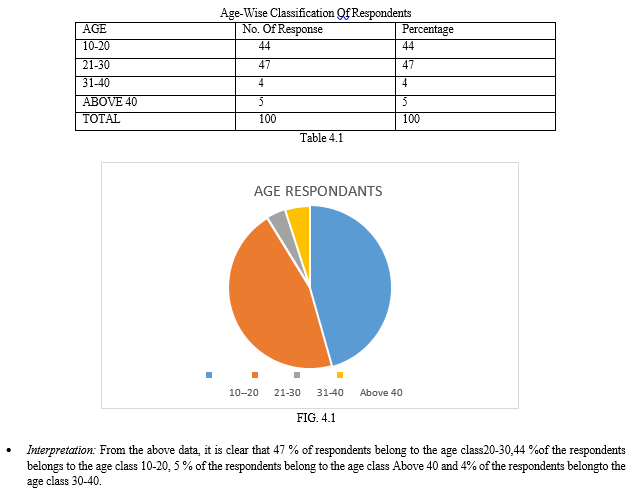
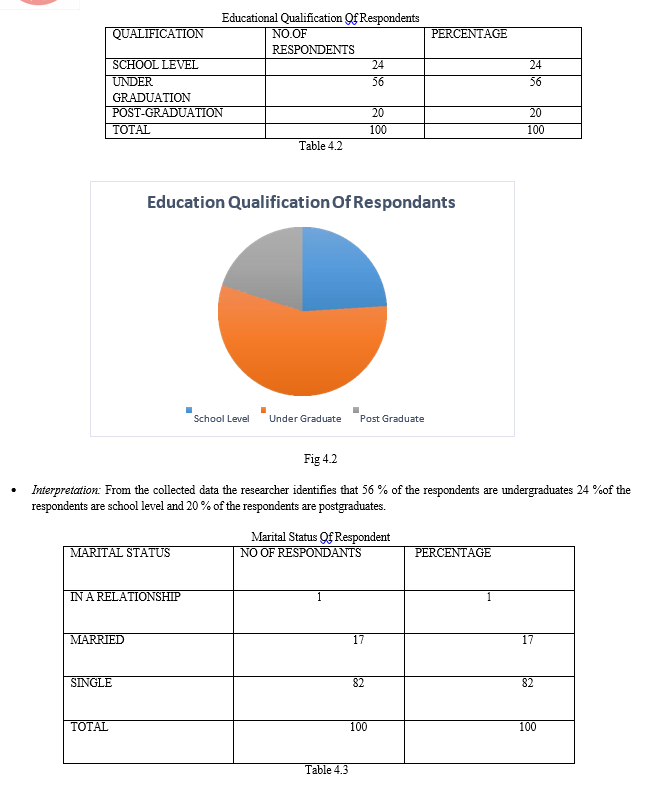
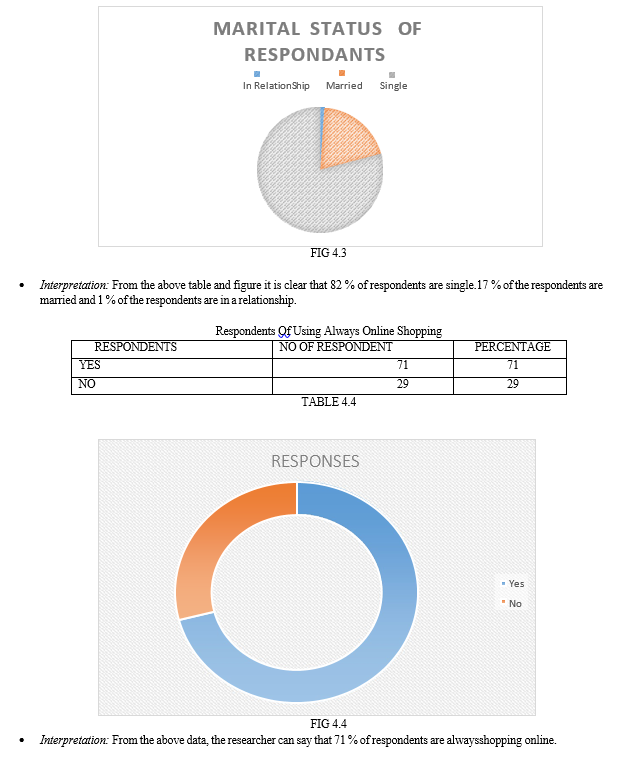

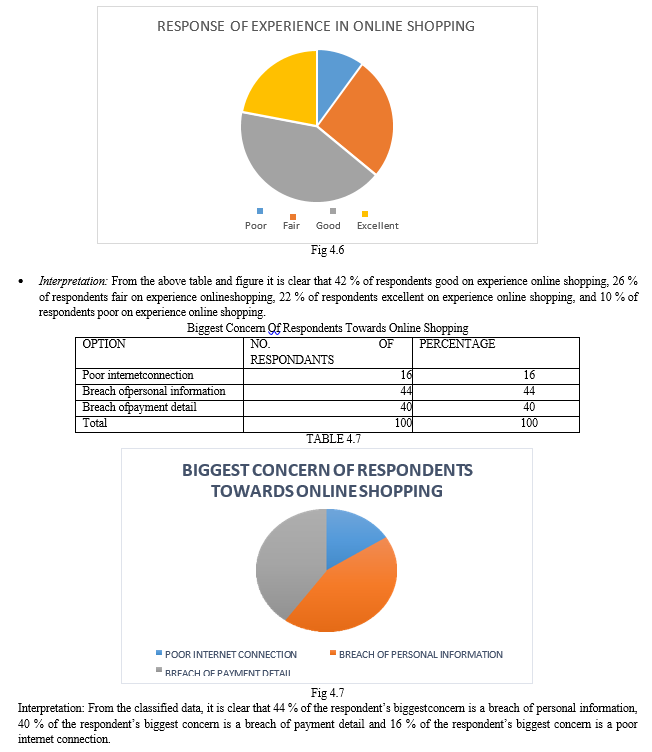
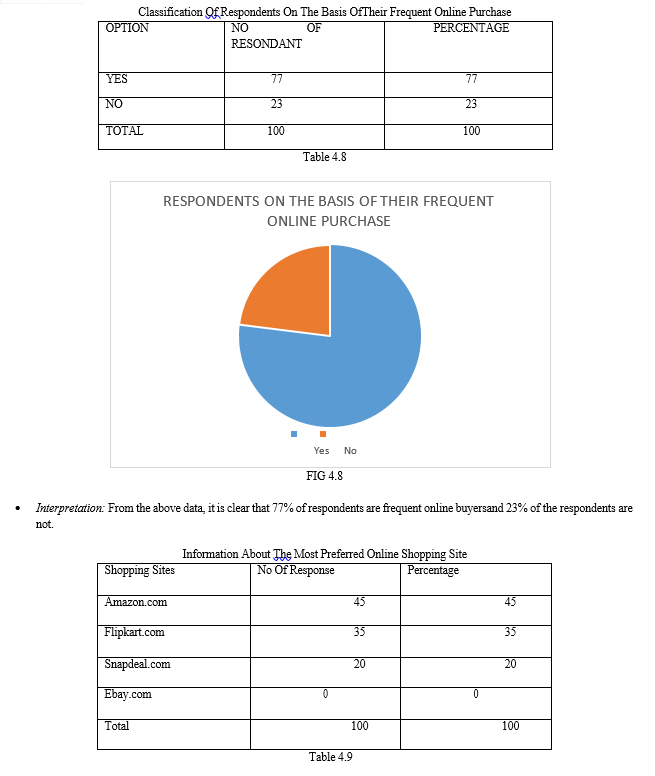
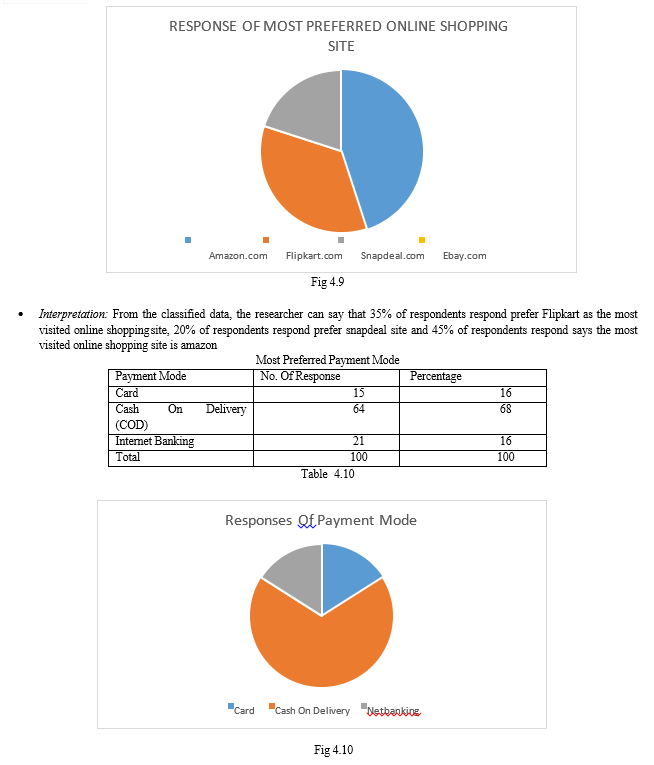

V. ACKNOWLEDGEMENT
I am pleased to acknowledge my sincere thanks to School of business for their kind encouragement in doing this project and for completing it successfully. I am grateful to them.
I would like to express my sincere and deep sense of gratitude to my Project Guide Dr. K.H Pavitra Prof. , School of Business, galgotias university, for her valuable guidance, suggestions and constant encouragement paved way for the successful completion of my project work.
I wish to express my thanks to all Teaching and Non-teaching staff members of the School of Management Studies who were helpful in many ways for the completion of the project.

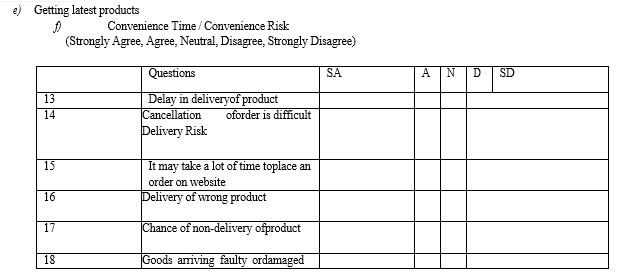
Conclusion
The study entitled “A study on the topic consumer behavior towards online shopping has been conducted to analyze and evaluate consumer behavior towards online shopping. The study has been conducted by collecting primary data with the help of a structured questionnaire from 100 respondents. The collected primary data have been analyzed and interpreted with help of ratios and percentages and the analysis is presented in the form of tables and charts. A. Findings of the Study on Consumer Behavior towards Online Shopping The major findings of the study on Consumer Behavior towards Online Shopping are: 1) 91% of respondents are belonging to the age group of 10- 30. 2) Majority of respondents (56%) are under graduates. 3) 82% of respondents are single. 4) 73% of respondents are enjoying shopping in online websites 5) 71 % of respondents are always shopping online.. 6) Only 77% of respondents are frequently conduct online buying. 7) Most preferred (45%) online shopping site is Amazon 8) Most preferred payment mode is cash on delivery. 9) 44 % of the respondent’s concerned about breach of personal information. 10) 28% of customers prefer online shopping for time saving. 11) 24% is Getting latest product. 12) 42 % of respondents good on experience online shopping B. Suggestions 1) Providing more competitive price can attract customers. 2) Online shopping sites should increase the security for online payment. 3) More attractive offers on products can attract more customers. 4) Measures to be taken in order to avoid delivery of duplicate products. 5) Measures to be taken in order to reduce delivery of damaged products. C. Conclusion After completing the project, it is revealed that customers are partially satisfied with online shopping. Some corrections in the facility can fully satisfy the customers. Online shopping sites provide a big platform for customers for shopping and they can save time by shopping online. By removing the online frauds, sites can create a high place in the mind of customers. Customers need fast delivery of good quality products, a wide range of products and competitive prices are of the main factor that attracts people towards online shopping, more improvements in this two field attract people more. Online shopping provides an important role in the mind of customers.
References
[1] Armstrong, Gary. Y Kotler, Philip (2003), “Fundaments de marketing”, Editorial Prentice Hall, 6a Edition, pp.14-15. [2] Bansal and Suita Pant (2005), ‘Encyclopedia of India’, Delhi: Smite Books. [3] Botha, J, Botham, C, Geldenhuys, P (2008), ‘Managing E-Commerce in Business’, Cape Town: Juta and Company Ltd, pp.3. [4] Del. I Hawkins, David. L Mothersbaugh, Roger. J Best (2007), ‘Consumer Behavior: Building Marketing Strategy’, McGraw-Hill/Irwin. [5] Donald, R Cooper & Pamela S Schindler (2007), Business Research Methods, Tata McGraw Hill, New Delhi. [6] Engel. J.F, Kollat. D.T and Blackwell. R.D (1968), ‘Consumer Behaviour’, Holt, Rinehart and Winston. [7] Enis. B.M (1974), ‘Marketing Principles: The Management Process’, pp.228. [8] Hollensen, S (2004), ‘Global Marketing a decision-oriented approach’, Essex: Pearson Education, 3rd Edition. [9] Kotler. P and Keller. K (2011), ‘Marketing Management’, 14th Edition, London: Pearson Education. [10] Abadi, D.R.H. Hafshejani, A.N.S and Zadeh, K.F (2011), ‘Considering Factors that Affect User’s Online Purchase Intentions with Using Structural Equation Modeling’, Interdisciplinary Journal of Contemporary Research in Business, Vol.3, No.8, Pp.465-468. [11] Aimol Agift, VermaRekha and Chacko Nisha (2014), ‘Consumers Attitude towards [12] Online Shopping’, Research Journal of Community and Consumer Sciences, International Science Congress Association, Vol.2, No.8, pp.4-7. [13] Ajay Kumar (2016), ‘Beyond Buying to Shoppers: Motivation towards Online Shopping’, BVIMSR’s Journal of Management Research, Vol. 8, Issue-1. [14] Alba, J. Lynch, J. Weitz, B. Janiszewski, C. Lutz, R. Sawyer, A. and Wood, S (1997), ‘Interactive Home Shopping: Consumer, Retailer and Manufacturer Incentives to participate in Electronic marketplaces’, Journal of Marketing, vol.61, No.3, pp.38-53. [15] Al-Azzam, Abdel Fattah Mohmoud (2014), ‘Evaluating the Antecedents of Online Consumer Purchasing Behaviour: An Empirical Study based on Theory of Planned Behaviour’, International Journal of Economics, Commerce and Management, Vol. II, Issue-4, pp. 1-18. [16] Aldrich.M (2011), ‘Online Shopping in the 1980s’ IEEE Annals of the History of Computing, Vol.33, No.4, pp.57-61.
Copyright
Copyright © 2024 Kunal Kumar Verma, Dr. K. H Pavitra. This is an open access article distributed under the Creative Commons Attribution License, which permits unrestricted use, distribution, and reproduction in any medium, provided the original work is properly cited.

Download Paper
Paper Id : IJRASET61059
Publish Date : 2024-04-26
ISSN : 2321-9653
Publisher Name : IJRASET
DOI Link : Click Here
 Submit Paper Online
Submit Paper Online

